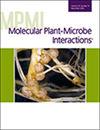求助PDF
{"title":"SymRK Regulates G-Protein Signaling During Nodulation in Soybean (<i>Glycine max</i>) by Modifying RGS Phosphorylation and Activity.","authors":"Swarup Roy Choudhury, Sona Pandey","doi":"10.1094/MPMI-04-24-0036-R","DOIUrl":null,"url":null,"abstract":"<p><p>Molecular interspecies dialogue between leguminous plants and nitrogen-fixing rhizobia results in the development of symbiotic root nodules. This is initiated by several nodulation-related receptors present on the surface of root hair epidermal cells. We have shown previously that specific subunits of heterotrimeric G-proteins and their associated regulator of G-protein signaling (RGS) proteins act as molecular links between the receptors and downstream components during nodule formation in soybeans. Nod factor receptor 1 (NFR1) interacts with and phosphorylates RGS proteins to regulate the G-protein cycle. Symbiosis receptor-like kinases (SymRK) phosphorylate Gα to make it inactive and unavailable for Gβγ. We now show that like NFR1, SymRK also interacts with the RGS proteins to phosphorylate them. Phosphorylated RGS has higher activity for accelerating guanosine triphosphate (GTP) hydrolysis by Gα, which favors conversion of active Gα to its inactive form. Phosphorylation of RGS proteins is physiologically relevant, as overexpression of a phospho-mimic version of the RGS protein enhances nodule formation in soybean. These results reveal an intricate fine-tuning of the G-protein signaling during nodulation, where a negative regulator (Gα) is effectively deactivated by RGS due to the concerted efforts of several receptor proteins to ensure adequate nodulation. [Formula: see text] Copyright © 2024 The Author(s). This is an open access article distributed under the CC BY-NC-ND 4.0 International license.</p>","PeriodicalId":19009,"journal":{"name":"Molecular Plant-microbe Interactions","volume":" ","pages":"765-775"},"PeriodicalIF":3.4000,"publicationDate":"2024-11-01","publicationTypes":"Journal Article","fieldsOfStudy":null,"isOpenAccess":false,"openAccessPdf":"","citationCount":"0","resultStr":null,"platform":"Semanticscholar","paperid":null,"PeriodicalName":"Molecular Plant-microbe Interactions","FirstCategoryId":"99","ListUrlMain":"https://doi.org/10.1094/MPMI-04-24-0036-R","RegionNum":3,"RegionCategory":"生物学","ArticlePicture":[],"TitleCN":null,"AbstractTextCN":null,"PMCID":null,"EPubDate":"2024/11/27 0:00:00","PubModel":"Epub","JCR":"Q2","JCRName":"BIOCHEMISTRY & MOLECULAR BIOLOGY","Score":null,"Total":0}
引用次数: 0
引用
批量引用
Abstract
Molecular interspecies dialogue between leguminous plants and nitrogen-fixing rhizobia results in the development of symbiotic root nodules. This is initiated by several nodulation-related receptors present on the surface of root hair epidermal cells. We have shown previously that specific subunits of heterotrimeric G-proteins and their associated regulator of G-protein signaling (RGS) proteins act as molecular links between the receptors and downstream components during nodule formation in soybeans. Nod factor receptor 1 (NFR1) interacts with and phosphorylates RGS proteins to regulate the G-protein cycle. Symbiosis receptor-like kinases (SymRK) phosphorylate Gα to make it inactive and unavailable for Gβγ. We now show that like NFR1, SymRK also interacts with the RGS proteins to phosphorylate them. Phosphorylated RGS has higher activity for accelerating guanosine triphosphate (GTP) hydrolysis by Gα, which favors conversion of active Gα to its inactive form. Phosphorylation of RGS proteins is physiologically relevant, as overexpression of a phospho-mimic version of the RGS protein enhances nodule formation in soybean. These results reveal an intricate fine-tuning of the G-protein signaling during nodulation, where a negative regulator (Gα) is effectively deactivated by RGS due to the concerted efforts of several receptor proteins to ensure adequate nodulation. [Formula: see text] Copyright © 2024 The Author(s). This is an open access article distributed under the CC BY-NC-ND 4.0 International license.
SymRK 通过改变 RGS 磷酸化和活性来调节大豆(Glycine max)拔节过程中的 G 蛋白信号转导。
豆科植物与固氮根瘤菌之间的种间分子对话导致了共生根瘤的发育。这是由存在于根毛表皮细胞表面的几种与结瘤相关的受体启动的。我们之前已经证明,在大豆的结核形成过程中,异源三聚体 G 蛋白的特定亚基及其调控 RGS(G 蛋白信号调节器)蛋白是受体和下游成分之间的分子联系。结节因子受体 1(NFR1)与 RGS 蛋白相互作用并使其磷酸化,从而调节 G 蛋白循环。共生受体样激酶(SymRK)将 Gα 磷酸化,使其失去活性,不能用于 Gβγ。我们现在发现,与 NFR1 一样,SymRK 也能与 RGS 蛋白相互作用,使其磷酸化。磷酸化的 RGS 具有更高的 GTP 加速活性,有利于活性 Gα 向非活性形式转化。RGS 蛋白的磷酸化与生理有关,因为过量表达磷酸化模拟版本的 RGS 蛋白会增强大豆中结核的形成。这些结果揭示了在结瘤过程中 G 蛋白信号传递的复杂微调,在多个受体蛋白的协同作用下,负调控因子(Gα)被 RGS 有效失活,以确保充分结瘤。
本文章由计算机程序翻译,如有差异,请以英文原文为准。

 求助内容:
求助内容: 应助结果提醒方式:
应助结果提醒方式:


